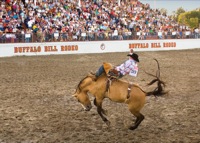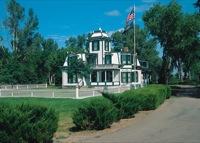 All photos by R. Neibel, courtesy Nebraska Tourism
All photos by R. Neibel, courtesy Nebraska Tourism
Groups visiting North Platte, Neb., get a personal greeting from a famous local resident. Well, at least his look-alike.
“A man on a white horse dressed as Buffalo Bill greets buses as they come into the park,” said Lisa Burke, executive director of the North Platte-Lincoln County Convention and Visitors Bureau. “He welcomes them to his ranch and speaks to them as Buffalo Bill.”
William F. Cody, the Indian scout, buffalo hunter and showman better known as Buffalo Bill, staged his first Wild West Show in North Platte, a major center on the Union Pacific railroad, and in 1886 built an elegant Victorian house on a 4,000-acre spread there.
 The house and a huge barn with “Scout’s Rest” — Cody’s name for his ranch — painted on the roof are preserved as part of the Buffalo Bill State Historical Park.
The house and a huge barn with “Scout’s Rest” — Cody’s name for his ranch — painted on the roof are preserved as part of the Buffalo Bill State Historical Park.
“He named it Scout’s Rest, but locals just call it ‘the ranch,’” said Burke.
The greeting by Buffalo Bill — aka local real-estate agent Bruce Richmond decked out in Cody’s trademark buckskin, with white goatee and long, flowing white hair — at the ranch is the first stop on the CVB’s Ride With the Wild Bunch program for motorcoach groups that spend the night in the central Nebraska town.
It is followed by tours of the house and the barn.
“The house is restored to late-1800s, turn-of-the-century appearance,” said site manager Steve Kemper. “Although all of the furniture is of the type he would have had, only four to five large pieces belonged to him or a daughter.”
Those include an antler chair and a roll-top desk and chair in his office and a dresser he took with him on the road. Display cases in the bedrooms contain some of his personal artifacts, including one of his hats.
 The 140-foot-by-70-foot barn has displays of horse-drawn equipment, saddles and original posters from Cody’s Wild West Show that he pasted on the walls.
The 140-foot-by-70-foot barn has displays of horse-drawn equipment, saddles and original posters from Cody’s Wild West Show that he pasted on the walls.
“We have an interpretative film that is 17 minutes long in a small theater in the barn that seats 60,” said Kemper. “It’s worth the time. It has some original footage of the Wild West by [Thomas] Edison. When you walk out of there, you have a pretty good feel for Ole Bill.”
Another realistic feel for the Old West occurs on the way to the group’s next stop, the Lincoln County Historical Museum, when a group of local Western re-enactors hold up their motorcoach. The re-enactors also stage a shootout in the Old West village at the museum, which includes several historic buildings, such as the old Fort McPherson headquarters, a one-room school, a sod house and an 1899 Sears & Roebuck mail-order house.
Groups then have a barbecue meal in the main museum building and are entertained by either a cowboy poet or an old-time cowboy band.
The next morning, groups are exposed to North Platte’s other main claim to fame: the railroad.
“It [the Wild Bunch program] is packaged with the Golden Spike,” said Burke. “We send them over in the morning, and they get to see some of the more than 10,000 railcars that pass through North Platte each day.”
North Platte is the site of the Union Pacific’s Bailey Yard, recognized by the Guinness Book of Records as the world’s largest rail yard.
“It is a classification yard,” said Burke. “It takes trains apart, sorts them and puts them back together.”
 The eight-story Golden Spike Tower, which opened in June 2008, provides a panoramic view of the massive yard, which is 8 miles long and 2 miles wide and covers 2,850 acres.
The eight-story Golden Spike Tower, which opened in June 2008, provides a panoramic view of the massive yard, which is 8 miles long and 2 miles wide and covers 2,850 acres.
“We have 315 miles of track,” said JoAnne Hoatson, manager of the tower and visitors center. “You can see Bailey Yard from an outside deck and an indoor observation area.”
The observation area has displays and exhibits that explain what is going on below. “They explain a little about what you are going to see and about the yard itself, from where it started to where it is today, and what some of the jobs are,” said Hoatson. “You see people working, but it is not necessarily clear what they are doing.”
The best information comes from retired railroad workers who volunteer as guides and ad-hoc teachers at the center.
“We typically match a group with a volunteer,” said Hoatson. “The volunteers are a generation of men for whom the railroad was their life. The railroad was good to them. They are really passionate about sharing that experience with visitors. It truly adds to the [visitor] experience.”
 The Golden Spike Tower also has a courtyard centered amid flagpoles with the state flags of 23 states. “They represent each of the states the Union Pacific currently goes through,” said Hoatson. “We also have a memorial brick pavilion, a gift shop and a dining car we are refurbishing.”
The Golden Spike Tower also has a courtyard centered amid flagpoles with the state flags of 23 states. “They represent each of the states the Union Pacific currently goes through,” said Hoatson. “We also have a memorial brick pavilion, a gift shop and a dining car we are refurbishing.”
Groups then tour Cody Park, site of the first Wild West Show, and its Railroad Museum, whose displays include the Challenger 3977, one of the largest steam locomotives ever built.
The museum also has a baggage car, a mail car, a caboose and a restored train depot.
After visiting North Platte, groups can head 20 miles south for a fascinating look at the life of the local inhabitants 1,000 years ago.
“We depict life 1,000 years ago that was a prime time for the Native American people in the area,” said Les Hosick, who with his wife, Jan, owns and operates the Dancing Leaf Cultural Center. “We show what life was like before the white man.”
The center includes a reconstructed earth lodge like those used by a group of Native Americans known as the Upper Republican Culture, believed to be ancestors of the Pawnee. In the lodge, which took more than 400 man hours to build, native trees support more than 200 rafter poles, which in turn support willows and prairie hay, which is covered with 12 to 18 inches of dirt.
 “Our concept of a house is different,” said Hosick. “Theirs were more shelter; they were outside people. We try to replicate the whole situation on a hilltop, where they would have had their earth lodges. They were isolated, not in villages. You would find them scattered up and down these little creeks.”
“Our concept of a house is different,” said Hosick. “Theirs were more shelter; they were outside people. We try to replicate the whole situation on a hilltop, where they would have had their earth lodges. They were isolated, not in villages. You would find them scattered up and down these little creeks.”
At the center, groups can get a buffalo stew meal made up of buffalo meat, beans, corn, sage, onions, sunflower seeds and muffins from blue corn. “It’s close to what we can tell they were raising,” said Jan Hosick.
From Buffalo Bill to buffalo stew, North Platte provides groups with a delicious and interesting taste of Western heritage.










